
|   |

|   |
12th Rasheswar Saikia Barbayan Sattriya Award 2020 - Nita Vidyarthi e-mail: nitavidyarthi@gmail.com Photos courtesy: Sangeet Sattra August 23, 2020 To mark respect to its Founder Principal, the late Sattriya Guru Rasheswar Saikia Barbayan, Sangeet Sattra, Guwahati, honours distinguished personalities in the field of the performing arts every year on July 8th, his birth anniversary, with an elaborate ceremony followed by a grand three-day annual music and dance festival featuring distinguished and renowned artistes, together with the acclaimed students of the Guru and their students. The legendary guru not only gifted Sattriya culture to the national and global music and dance scenario but under rigorous constraint and strong criticism, broke conventions by teaching women the dance form for the first time. To propagate and take forward his legacy and pioneering endeavour through his very own 52year-old institution Sangeet Sattra, the first in Assam and the country to teach Sattriya culture systematically, are his two able dancer-daughters, Ranjumoni and Rinjumoni Saikia. 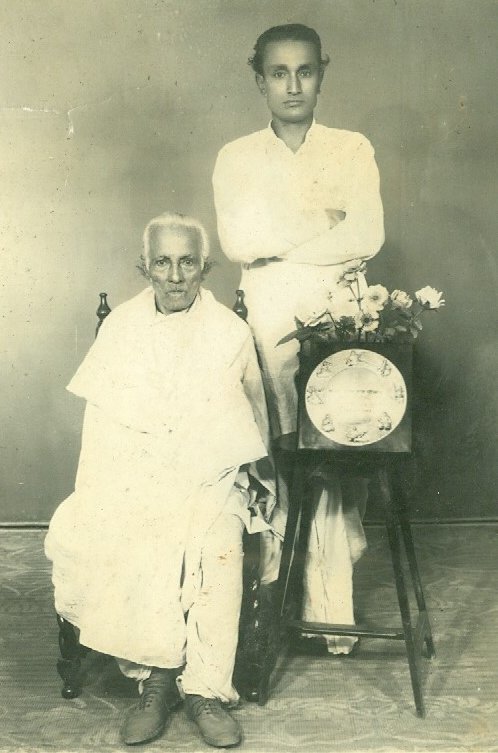 Guru Rasheswar Saikia with his Guru Maniram Dutta Muktiar Barbayan, the first Sangeet Natak Akademi Award winner of Sattriya 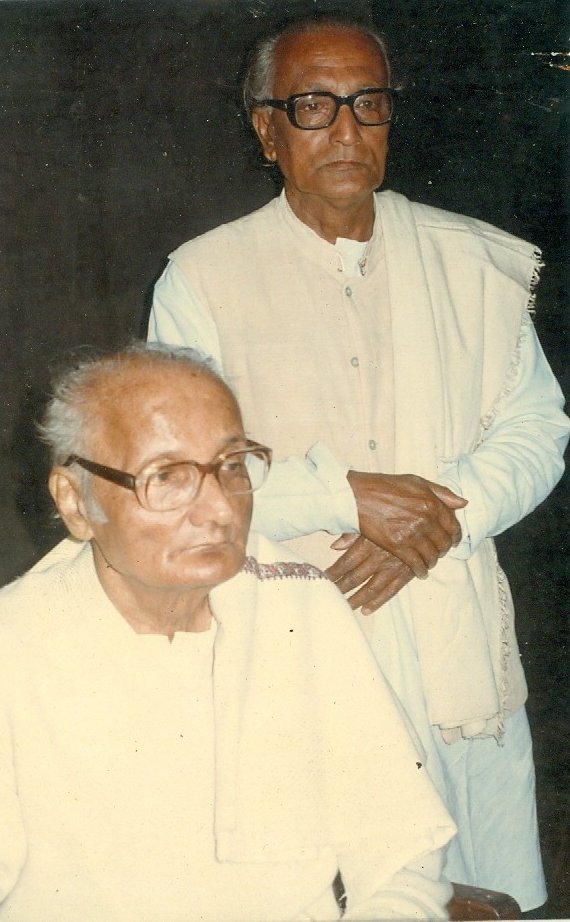 Guru Rasheswar Saikia (founder principal) with Dr. Maheswar Neog (founder president of Sangeet Sattra) 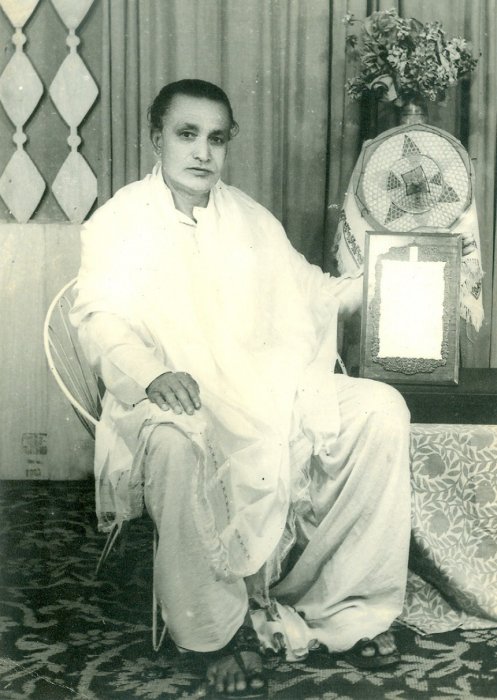 Guru Rasheswar Saikia after receiving the Sangeet Natak Akademi Award in 1980 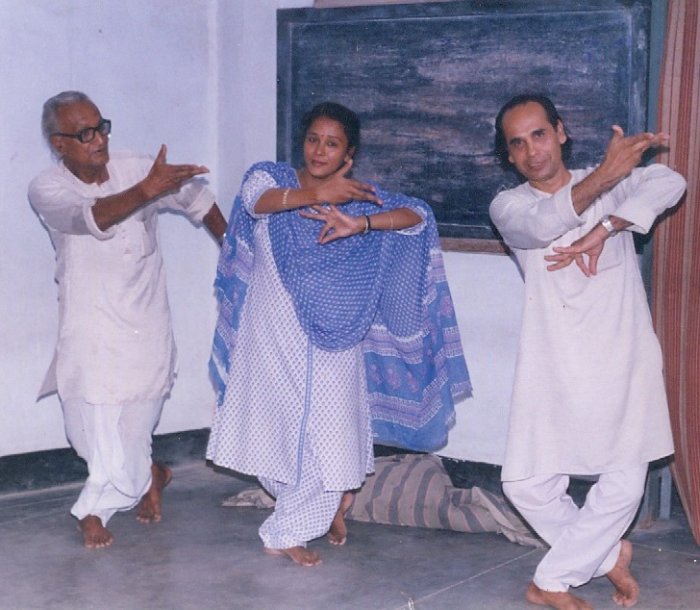 Guru Rasheswar Saikia Barbayan with daughter Ranjumoni Saikia and Ghanakanta Bora Barbayan The Rasheswar Saikia Barbayan Sattriya Bota (award) instilled in 2009 by distinguished personalities and connoisseurs of arts from Assam is continued by Sangeet Sattra since 2013. It is awarded to eminent personalities in recognition for their immense lifetime contribution in the field of performing arts - dance and music - especially Sattriya culture. Otherwise a glittering event, this year the ceremony was celebrated on a digital platform for three days with austerity due to the Corona pandemic. Conceived with remarkable discretion, aesthetic planning and prudent time management, elder daughter Ranjumoni Saikia, arranged the virtual ceremony with shared memories, nostalgic tributes embellished with old "out of the cupboard" photographs that were a captivating enrichment of the arts. It brought in speeches by dignitaries and words of thanks and gratitude by awardees on the first day and the Guru's veteran, distinguished and celebrity students on the second. A variety of live and short uploaded performances to offer a glimpse of Sattriya music and dance were slated for the third. It was not an immersion of a full program or concert. The photographs had memorable stage events like the Bhaona "Ram Bijoy" with the stunning performances of Nrityacharya Jatin Goswami, memorable and historic moments with celebrities like the son of the soil Bhupen Hazarika and the former President of India, Fakhruddin Ali Ahmed with the Guru and many more. Some of the family with renowned artists of Assam added a warm, joyous and nostalgic touch. 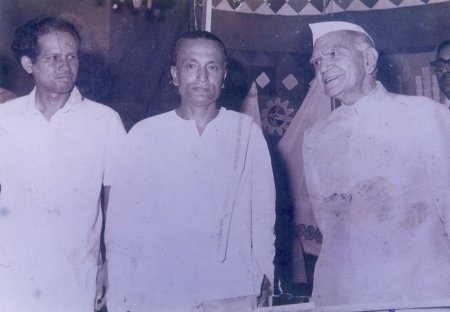 Guru Rasheswar Saikia with then chief minister of Assam, Tarun Gogoi and then President, Fakhruddin Ali Ahmed 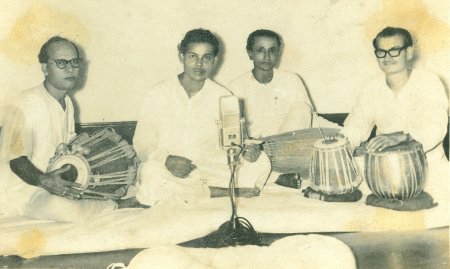 The first time Khol (the prime percussion of Sattriya tradition) was amalgamated with other major forms of music 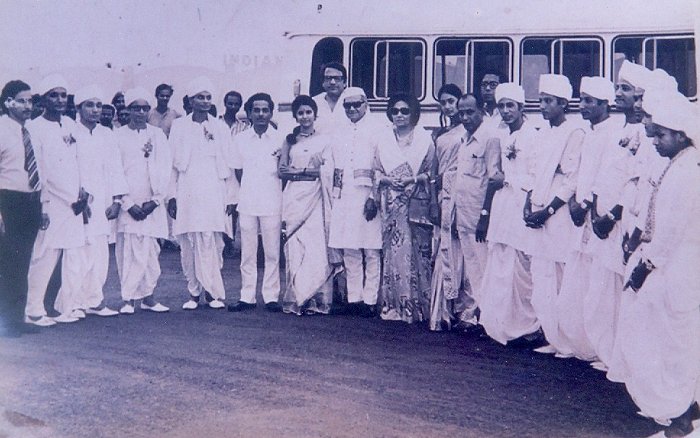 The first time Sattriya was performed on an international stage in Indonesia under the leadership of Guru Rasheswar Saikia A picturesque flourish of natural lush green foliage, flower bedecked garden or a cozily decorated verandah with potted Erika palms as a background for the videos of commentary by the anchors created an aura of creative freedom. And these were a balm to the tired eyes of the viewers who at this juncture are often used to seeing a curtained wall, drawing room and inner space of the performer's house or a roof top in the virtual initiatives. Excellent videography by Arupjyoti Kalita and Arunabhjyoti Malakar, the very popular khol player of the present generation with a 'Bayan' title from his grandfather's Old Kamalabari Sattra, and the son of Ranjumoni Saikia, was of high quality resolution, sound and artistry. The streaming was unusually smooth and would do well for a professionally shot coloured documentary. Arunabh shared the extra burden of an interviewer (with good homework) and an articulate anchor together with Usha Rani Baishya and Jollymoni Saikia. Everyone contributed in totality to the creative process of the presentation. A special word of thanks from Sangeet Sattra went to Partha Pratim Baruah. Classy music in the prelude and the interlude, especially the flute to initiate the program and also while connecting the transition from zone to zone, of speaker to speaker was an impressive entertainer to reduced monotony and impatience. DAY ONE 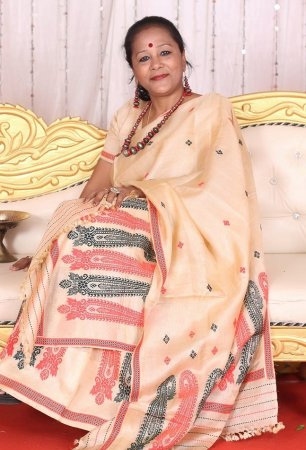 Ranjumoni Saikia  Sonaram Sarma Burahbhakat Maintaining tradition, the event began with a warm welcome address by Swapnil Barua, the executive President of Sangeet Sattra. After a brief introduction about the background of the Guru, his institution Sangeet Sattra, the painstaking efforts of Ranjumoni and Rinjumoni Saikia and their associates in maintaining the high standard and excellence of the institution, Barua introduced the event in detail, seeking the good wishes and blessings for Sangeet Sattra from all attending through the virtual mode and formally announced the names of the awardees. This year's awardees include Sonaram Sarma Burahbhakat of Mul Kamalabari Sattra and the eminent Manipuri dancer Guru Kalavati Devi. 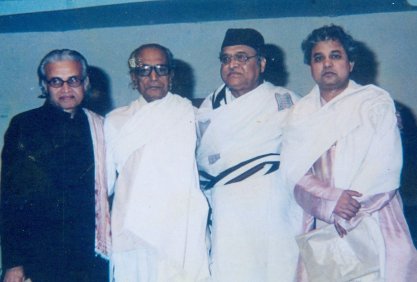 Dr.Sunil Kothari, Guru Rasheswar Saikia, Dr. Bhupen Hazarika and Pt. Jayant Kastuar Kusum Kumar Mahanta, Secretary, Asom Sattra Mahasabha during his brief reminiscences very respectfully offered his gratitude to Guru Rasheswar Saikia for altering the name of the prestigious state literary organisation from Asom Sattra Sangha to Asom Sattra Mahasabha. Mahanta personally felt very touched and grateful for the inception of the word 'Mahasabha.' He concluded by wishing to spread the guru's "bani" and message to the future generation. After explaining the purpose of the digital endeavour, Rinjumoni Saikia welcomed distinguished dance scholar Dr. Sunil Kothari to share his days with the maestro. Exploring memories loaded with sensory and practical experience of the nitty-gritty of the grammar of the Sattriya dance obtained from the maestro came as gratifying information spiced with anecdotes of Dr. Kothari's time spent with Guru Rasheswar Saikia. The old photographs with the guru were of an added interest. 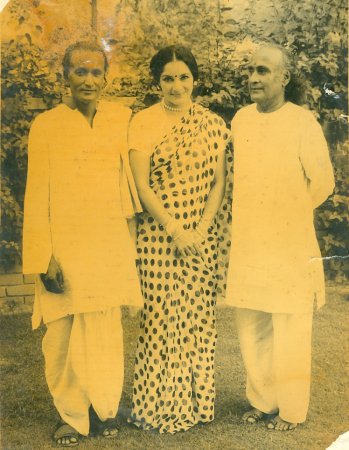 Guru Rasheswar Saikia with Indrani Rahman and Guru Gopinath Jayant Kastuar, acclaimed Kathak dancer and former Secretary of the Sangeet Natak Akademi, spoke on Guru Rasheswar Saikia's untiring efforts in informing, narrating the importance of Sattriya culture during his several visits to Kastuar's office in New Delhi and his struggle for Sattriya dance to be recognized as a classical form of India. The number of photographs at different intervals of time and venues were witness to his long association with the Master. He fondly mentioned of his old diary in which he had noted his discussions with the guru and regretted that the maestro passed away a short time before his lifetime wish was fulfilled in the year 2000. Raju Das, Deputy Secretary of Sangeet Natak Akademi, praised the efforts of the Saikia sisters in carrying forward the legacy. Sonaram Sarma Burahbhakat in his elaborate and insightful speech brought forth the imagery of a powerfully determined man who fought for and sacrificed (the bhakat used a strong term "aahuti") and finally succeeded in bringing the Sattriya culture from the Namghar to the modern proscenium. He mentioned how the doyen "roared like a lion" to get the classical tag for the dance form. His long speech swelled with thrill, admiration, reverence and pride. To him, teaching Sattriya dance to women was a historic movement of "nari mukti" (freedom of women) and bringing Sattriya culture to the masses a "jana jagaran." His uninterrupted steady deliberation in his Sattra room demanded full attention and was no less than a valuable discourse. Guru Kalavati Devi expressed her joy in receiving the award by sending a thank you message that was reflected on the screen. DAY TWO Arunabhjyoti visited Nrityacharya Jatin Goswami, Guru Rasheswar Saikia's long time associate, to speak to the living legend of Sattriya dance. Goswami gave a detailed account of the maestro's journey from Kamalabari Sattra to Tinsukia town, to Guwahati for the establishment of Sangeet Sattra and also about the background of the inception of the prestigious award in his memory in which the Nrityacharya played an active part. His talk highlighted a number of artistic and performative details hitherto unknown and declared emphatically that "Rasheswar Saikia's contribution to Sattriya culture cannot be valued." He discussed the making of the Bhaona 'Ram Bijoy' in Tinsukia under the directorship of the Master where the Nrityacharya performed and informed that the acting was directed by the great Kalaguru Vishnu Prasad Rabha. The photographs were a trip down memory lane. Bayanacharya Ghanakanta Bora, Guru's prime disciple, was full of awe, admiration and gratitude for his guru who had learnt Bayan from the great Guru Maniram Dutta Muktiar of the Kamalabari Sattra. He praised the teaching, the infrastructure and the working of Sangeet Sattra and its examination centres in different parts of the state profusely. Sharodi Saikia mentioned about the famous Sattriya artistes from whom her Guru had honed his skills. Gobinda Saikia, Ramkrishna Talukdar and Anita Sharma reminisced their days with the doyen. DAY THREE 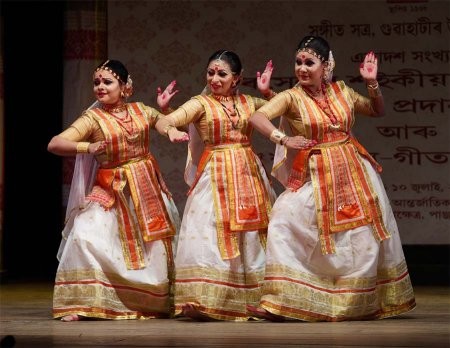 Sukanya Deka, Elizi Ozha and Juri Das Eminent cultural activist Druna Kanta Bhagawati narrated in detail, the guru's journey from a devoted Vaishnavite to a trailblazer. He considered Sangeet Sattra to be one of the best in the country in systematic and authentic dance education. Its brilliance was confirmed once again by Khagen Bhuyan and Haricharan Saikia. The invocation of the evening was Sri Madhavdeva's Borgeet "Mono re" by Arun Hazarika set to raga Asawari and rakta taal, followed by a delightful Sattriya dance recital - a Krishna Vandana - a part of the namghosha, by the artists Juri Das, Elizi Ozha and Sukanya Deka of Sangeet Sattra. A well-coordinated pure dance item 'Gopi Nach' followed. They concluded with refined presentation of Saint Madhavdeva's famous Borgeet "Kamal nayan aaju pekhalu mayee" (Mother, see the lotus-eyed ) set to raga Pahadi, ektal and Kharaman.  Pankaj Saikia on khol, Pallab Bora Bayan on cymbals 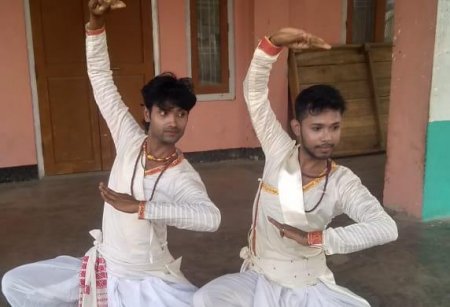 Dadu Dutta and Ayan Raj Saikia Pankaj Saikia Barbayan of Mul Kamalabari Sattra entertained with khol vadan accompanied on the cymbals by Pallab Bora Bayan of Bhogpur. The colourful artistic backdrop drew attention. Dadu Dutta of Badula Sattra and Ayan Raj Saikia of Lakhimpur are consummate dancers with light-footed grace and offered a brilliant Behar Nach. The extremely graceful duo began with a sloka from Saint Sankardeva's Ankiya Nat 'Rukmini Haran' followed by a pure dance recital of 'Gosai Nach' which evoked majesty. In their entire recital, the use of metrical cycles, decorative hand gestures, nritta hastas, sthanas and bhramaris were highly stylised and precise showing strong matiakhara training. The closing item, an uploaded piece, was an appealing dance drama "Sankara Suro Prakasha"-the hagiography of Srimanta Sankaradeva in Brajawali language, conceptualised, scripted and directed by Usha Rani Baishya in two parts, incorporating all the elements of Sattriya dance beginning with a Sutradhar. 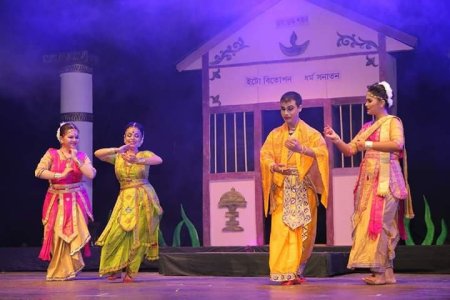 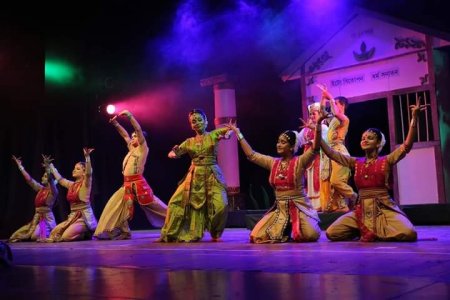
Dance drama Sati Radhika
The first part was about building of a dam. Set at the backdrop of the
Bhakti movement when the country was in the grip of a religious
upheaval, Saint Sankaradeva wanted to abolish the caste system and
establish unity. At that time, Tambuwani rivulet became devastating and
building a dam was impossible due to the high current. Villagers sought
Sankaradeva's help. He suggested that a chaste lady irrespective of
caste and creed should fetch water from the Brahmaputra and pour into
the mouth of Tambuwani. Finally it was a fisherman's wife, Sati Radhika,
who poured water, calmed down the rivulet which came to be known as
"Shantijan" and made possible the building of a dam. The second story
was about drought in Tambuwani, Bordowa where the villagers had no
drinking water and Saint Sankaradeva by his divine power created a pond
named "Akashi Ganga." Good dancing and teamwork made the dance
dramas interesting. The anchors were Arunabhjyoti Chitralekha Gogoi and
Bijita Goswami.Despite everything, online productions cannot replace a live performance but is definitely the best alternative to be connected with the performances and the virtual ceremony of Guru Rasheswar Saikia Barbayan Sattriya Bota was an excellently presented and recorded offering.  Dr. Nita Vidyarthi is a veteran critic of performing arts and writes on dance, music and theatre in leading publications. |